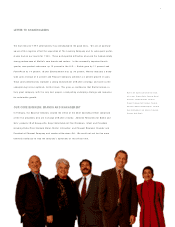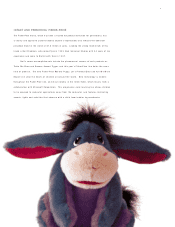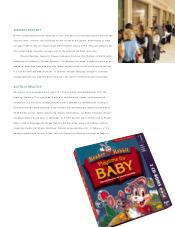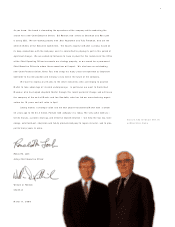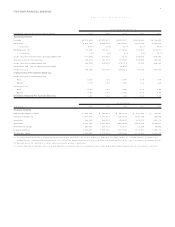Mattel 1999 Annual Report Download - page 13
Download and view the complete annual report
Please find page 13 of the 1999 Mattel annual report below. You can navigate through the pages in the report by either clicking on the pages listed below, or by using the keyword search tool below to find specific information within the annual report.
11
Mattel, Inc. and Subsidiaries
Results of Operations
The following is a percentage analysis of operating results for the past three years:
For the Year
19 9 9 1 9 9 8 1 9 97
Net sales 10 0 .0 % 10 0 .0 % 10 0 .0 %
Gross profit 47 .2 % 51 .8 % 51 .7 %
Advertising and promotion expenses 17 .2 16 .3 15 .5
Other selling and administrative expenses 21 .6 20 .3 18 .6
Amortization of intangibles 1.7 2.3 8.9
Restructuring and other charges 6.3 2.8 6.3
Charge for incomplete technology – 1.0 0.4
Other income, net ( 0 .3) ( 0 .2) ( 0 .1)
Operating profit 0.7 9.3 2.1
Interest expense 2.7 2.3 2.1
Income ( loss) before income taxes and extraordinary item ( 2 .0) % 7.0 % – %
1999 Compared to 1998
Consolidated Results
Net loss for 1 99 9 w as $ 82 .4 million or $0 .21 per diluted share as compared to net
income of $2 06 .1 million or $0 .47 per diluted share in 1998. The 19 99 results
were negatively impacted by restructuring and other charges totaling $3 46 .0 million,
approximately $2 65 million after-tax or $0 .64 per diluted share, related to the
Mattel restructuring plan, the merger and integration of Learning Company, and other
nonrecurring charges. Additionally, Mattel’s 19 99 results were negatively impacted by
the results of operations of its Learning Company division, which reported a pre-tax loss
of $2 05 .5 million for the full year 19 99 . The 1 998 results of operations were nega-
tively impacted by nonrecurring charges, including an incomplete technology writeoff of
$5 6.8 million related to the acquisition of Mindscape, Inc. in March 19 98 , restructuring
and other charges of $1 13 .3 million related to 19 98 acquisitions and one-time charges
of $4 4.0 million in connection with the voluntary recall of Pow er Wheels®ride-on
vehicles and a Toys R Us-related antitrust litigation settlement. Total 19 98 nonrecurring
charges of approximately $1 63 million after-tax impacted the earnings by $0 .39 per
diluted share.
The negative results of the Learning Company division in 19 99 were attribut-
able to a number of factors. In 1 99 9, Learning Company experienced a decrease in
sales of CD-ROM products at retail and a higher proportion of sales of relatively low er
priced and lower margin products. During the second half of 1999, Learning
Company was in the process of revising its distribution channel arrangements. These
changes in distribution terms combined with the general weakness in the CD-ROM
market resulted in increased product returns. Significant price and promotional com-
petition caused the Learning Company division to incur higher than anticipated price
concessions and marketing expenses, including increased use of rebate programs,
price protection and advertising. In addition, increased bad debt reserves of approxi-
mately $5 6 million, including $3 5 million related to one of Learning Company’s major
distributors, contributed to its operating loss.
In 2 00 0, Mattel will attempt to improve the results of its Learning Company
division by reducing the number of software products it develops and sells, decreasing
the length of its software product development cycle and eliminating a number of its
lower margin software titles. In addition, Mattel has implemented a more strict sales
control policy with its distributors and retailers and plans to decrease the use of rebates
to consumers and price and marketing concessions to distributors and retailers. Mattel
intends to focus on areas w here potential growth opportunities exist, including expan-
sion of its interactive products to new platforms such as game consoles and the
Internet, as well as increased sales in the international markets. Mattel also plans to
continue its strategy of creating stand-alone on-line ventures utilizing Learning
Company assets, such as Genealogy.com, LLC and GoodHome, LLC, in which Mattel
retains an equity interest, and will consider strategic dispositions, licensing agreements
and other similar transactions. In 1 99 9 and 20 00 , Mattel replaced the senior man-
agement at its Learning Company division. There can be no assurance that the
Learning Company division’s results w ill improve as a result of Mattel’s efforts.
Mattel is also currently undertaking a comprehensive review of its entire
interactive business to identify additional opportunities to improve operating productiv-
ity and realize costs savings. Following this review, Mattel expects to incur pre-tax
reorganizational charges totaling approximately $7 5 million to $1 00 million in the
first quarter of 20 00. These charges are designed to streamline the infrastructure,
product development cycle and operations of Mattel Interactive.
Net sales for 1 99 9 w ere $ 5.5 billion, a decrease of 2% from $5.6 billion in
19 98 . Sales to customers within the US remained relatively flat and accounted for
72 % and 71% of consolidated net sales in 19 99 and 1 99 8, respectively. Sales to
customers outside the US were down 6%, including an unfavorable foreign exchange
effect of approximately $2 2 million due to the generally stronger US dollar relative to
19 98 . At comparable foreign exchange rates, sales internationally declined by 4 %,
partially due to unfavorable industry-wide trends, especially the shift amongst
European retailers to just-in-time inventory management. Mattel plans to grow its
international business by adapting products to local tastes, economic conditions and
price requirements. To accomplish this goal, Mattel continues to work on an exten-
sive market-specific strategy aimed at improving sales of its core product lines in inter-
national markets. In addition, Mattel’s September 19 99 distribution agreement w ith
Bandai Co. Ltd. ( “ Bandai” ), the largest toy company in Japan, to distribute certain
Mattel products in Japan is also part of Mattel’s strategy for international growth and
market penetration.
Sales in the Girls category decreased 3% largely due to declines in Barbie®
and Cabbage Patch Kids®products, partially offset by incremental sales of American
Girl®products resulting from the Pleasant Company acquisition. Pleasant Company
was acquired in July 1 99 8 and therefore the results of operations for 19 98 only
reflect six months of results. Sales in the Infant and Preschool category declined 3 %,
largely attributable to last year’s success of Sesame Street®products, including ‘ Tickle
Me Elmo’ and decreased sales of Disney’s Winnie the Pooh®products, partially offset
by an increase in sales of core Fisher-Price®and Power Wheels®products. Sales in
the Wheels category grew 6%, demonstrating continued strength in Hot Wheels®,
Matchbox®, and Tyco®Radio Control. Sales in the Entertainment category, including
Disney and Nickelodeon®, increased 1 1% largely due to this year’s success of toys
associated with Disney’s feature motion picture ‘ ’ Toy Story 2’’ . Sales of Learning
Company consumer software products decreased 8 %, mainly due to a decrease in
sales of CD-ROM products at retail and a higher proportion of sales of relatively low er
priced and lower margin products. This decrease w as partially offset by an increase
in licensing revenues of approximately $5 0 million largely generated from licensing
agreements, including Genealogy.com, LLC in the third quarter of 1 99 9 and
GoodHome, LLC in the second quarter of 1 99 9. Mattel views e-commerce and licens-
ing transactions to be a significant source of potential revenues for its Learning
Company division and intends to continue to attempt to leverage the value of its
Internet properties through joint ventures, licensing and other similar transactions.


